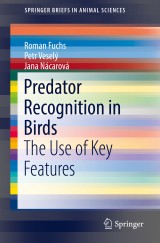Details

Predator Recognition in Birds
The Use of Key FeaturesSpringerBriefs in Animal Sciences
|
53,49 € |
|
| Verlag: | Springer |
| Format: | |
| Veröffentl.: | 27.03.2019 |
| ISBN/EAN: | 9783030124045 |
| Sprache: | englisch |
Dieses eBook enthält ein Wasserzeichen.
Beschreibungen
This SpringerBrief answers the question on how birds recognize their predators using multidisciplinary approaches and outlines paths of the future research of predator recognition. A special focus is put on the role of key features to discriminate against predators and non-predators. The first part of the book provides a comprehensive review of the mechanisms of predator recognition based on classical ethological studies in untrained birds. The second part introduces a new view on the topic treating theories of cognitive ethology. This approach involves examination of conditioned domestic pigeons and highlights the actual abilities of birds to recognize and categorize.
1 What do we know about predator recognition by untrained birds?.- 1.1 The study of predator recognition (How to make birds respond in etho-ecological experiments - to show that they recognized the predator – nest defense, feeder experiments, laboratory experiments…).- 1.2 Evidence for predator recognition ability (What predator categories birds recognize – predator vs. non-predator, aerial vs. terrestrial predators, individual predator species…).- 1.3 Tools used for predator recognition (What cues bird use for predator recognition – sign stimuli, coloration, size…).- 2 What can the recognition experiments with trained pigeons tell?.- 2.1 Category discrimination and concepts formation (How do birds form categories of predators – memorizing vs. generalization vs. conceptualization…).- 2.2 Object recognition (What cues birds use for predator recognition – particulate feature theory vs. recognition by components, local vs. global features…).- 2.3 Other cognitive processes (Are we able toreveal other cognitive processes in predator recognition by birds – amodal completion, priming…).
<div>Dr. Roman Fuchs <br></div><div><div>Department of Zoology </div><div>Faculty of Science </div><div>University of South Bohemia </div><div>Branišovská 1760 37005 </div><div>České Budějovice </div><div>Czech Republic </div></div><div><br></div>Dr. Petr Veselý <div>Department of Zoology</div><div>Faculty of Science </div>University of South Bohemia</div><div>Branišovská 1760 37005 </div><div>České Budějovice </div><div>Czech Republic <div><br></div></div><div>Dr. Jana Nácarová<br></div><div><div>Department of Zoology</div><div>Faculty of Science </div><div>University of South Bohemia</div><div>Branišovská 1760 37005 </div><div>České Budějovice </div><div>Czech Republic </div><div><br></div></div>
Provides a concise overview on avian predator recognition Discusses both ethological and cognitive approaches Describes in detail the use of key factors to recognize predators
Diese Produkte könnten Sie auch interessieren:

Auditory Signal Processing

von: Daniel Pressnitzer, Alain de Cheveigne, Stephen McAdams, Lionel Collet

213,99 €















